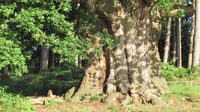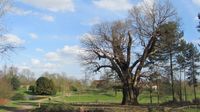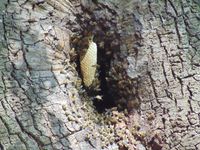"Whether alive and flourishing or decrepit and dying, each oak is a universe to be inhabited... I return to the embrace of the oak, tuck myself once more into that cranny in the western face, my back against the oak tree's bark."
We go into nature to be held by some ancient, powerful, and outstanding force. We go into nature to render our problems insignificant against substances hewn by rain and rock. We go into nature to offer our mortality to an indifferent space and then have it returned tested.
When you imagine nature, how do you imagine it? Is it an enclosure or a horizon? Is it brown, green, or blue? Are there trees? I've read so many writers who express a tree memory - a particular tree experience that parallels a dying grandparent or first love. Trees exact a human worship this side of idolatry. Apple and oak trees are the most frequently mentioned; is that because they are the giving trees?
 The Honywood Oak, Essex. September 5, 2012. Photograph by James Canton.
The Honywood Oak, Essex. September 5, 2012. Photograph by James Canton.The collective oak tree, extant for 2.6 million years, spread across the north following a massive ice melt. Its arrival and multi-seasonal 'gifts' fueled civilizations, empires, colonialization, discovery, and technology. Oaks meant life and change. "Oak trees were special," writes writer and academic James Canton in The Oak Papers, his moving, intimate portrait of an ancient oak.
They gave wood for the fire, but their trunks could also be worked to form the frames of the homes that sprung up on the freshly cleared ground. And oaks offered more than merely wood. They gave acorns that could easily be gathered and stored and later eaten so that both humans and animals could feed and stave off starvation in times of famine. There is evidence from prehistoric sites across Europe that those early farmers used acorn flour as a substitute when their own cereal crops failed. At one Bronze Age settlement near Berlin, a metre-deep store-pit was brimful of acorns that had been 'hulled, split and roasted' - that is to say, prepared for human consumption rather than as swine fodder. Throughout human history, acorn flour has been used to make bread. In various communities of the world, the practice continues.
A particular group of oaks, aided by genetics and England's climate, grew and thrived for centuries in the county of Essex. They witnessed humankind from the height of the medieval ages to the 20th century.
Out on the hill, old Oaks still stands:
stag-headed, fire-struck, bare-crowned,
stubbornly holding its ground.
[...]
Three hundred years to grow,
three hundred more to thrive,
three hundred years to die -
nine hundred years alive.
From Robert Macfarlane's "Oak," The Lost Spells
And then, in the 1950s, almost all of these ancient oaks - hundreds in total - were felled casually for timber—an unfathomable loss. A few survived, charred and hollowed. One remains intact: the Honywood Oak on the Marks Hill Estate in north Essex.
 Honywood Oak in Marks Hill Estate, Essex. April 16, 2013. Photograph by James Canton.
Honywood Oak in Marks Hill Estate, Essex. April 16, 2013. Photograph by James Canton.Canton's tender, measured story begins near this tree: "Some five years ago, I sought solace from the ways of the world by stepping into the embrace of an ancient oak tree."
To begin with, I went there for the gentle comfort sitting beside that grand oak offered. I could walk away from my work as a teacher, from my life and responsibilities, and place myself in a world that was something close to Eden. I could go beyond my world into that of the oak.
The Honywood Oak grows a few miles from Canton's longtime home. It edges the memory of what once was 2,500 acres of ancient woodland. Why this individual tree was spared, is a mystery and a mercy.
 Honywood Oak, May 12, 2013. Photograph by James Canton.
Honywood Oak, May 12, 2013. Photograph by James Canton.The still that settles upon the oak is that of the closing down of day - a gentle sighing that is broken by the harsh bark of a muntjac deer from the woods behind. The moon, so wide and white, soon vanishes behind cloud. I sit back on the memorial bench, nestling down against the dark. A pipistrelle bat catches in the corner of the torchlight and is framed for a moment, wide-winged. [...] Tonight the bats flitting across the night are indistinguishable to me. We still know so little.
In the woods behind, the first cry of a tawny owl breaks the night air, two, three hundred yards away. I sit tight and await the nightlife of the oak as the full moon returns through tears in the cloud that appear as though brief glimpses, windows, into another world far behind.
David Hockney sought trees during the COVID lockdown; he was eighty-three and daily painted trees whilst seated among them. Trees have magnetism inherent in their size and shape; they might not provide answers, but they do offer space to seek answers. Canton reflects on this space:
A gentle southerly threatens rain from patchy cloud. The day feels done though the dusk is a while away. I sit on the bench and wonder about a duality of desires: to care for the oak and to be cared for by the oak. It is a growing feeling that sits insecurely in me. I cannot frame the sense yet for the past few visits to the oak I have increasingly felt an unfathomable notion that the oak is in some way protecting me. For a while, I think of the delighted child that I am able to become beneath these boughs, and yet as I wonder on that fact that I know that in doing so, I endanger the becoming by destroying the enchantment.
As Canton sinks into the oak's vital warmth, he embraces the relinquishment of self we often find in nature. Touching rock, ice, and wood is to throw our heaviness against their unyielding force.
My hand upon the oak.
How do you explain that feeling, that rising emotion, which comes as your hand rests against an ancient oak? What is it we feel? Perhaps we do not always appreciate the significance of the value of that touch from one species to another species, from one individual to another individual. How do you explain that sensation which each human being knows when we, as one living creature, touch upon the life-force of another being of another species?
 Honywood Oak, April 8, 2013. Photograph by James Canton.
Honywood Oak, April 8, 2013. Photograph by James Canton.More than substance and material, Canton observes the oak is a universe - its laws, boundaries, and inhabitants providing the kind of world-creation that engrosses and enriches our child-like selves.
This is a battered and bruised oak, roots unearthed and skin torn. I look up and see the crown of the oak is also tattered - a stag-headed form long ago lost to a gale. Yet, like all oaks, whether torn and battered or grandly magnificent in appearance, this oak is a world for many thriving communities of creatures. Whether alive and flourishing or decrepit and dying, each oak is a universe to be inhabited. And I know that the stag-headed heights of the oak are merely the tree adapting to the dry conditions it finds itself in- the sandy soils, the exposed roots - and so is withdrawing within in order to save energy, stripping back to its essence. The jagged, lightning bolt of the stag-head does not mean the oak is dying. Rather, it means the oak is reacting to its environment, striving to survive, to live.
 Honywood Oak, August 2016. Photograph by James Canton
Honywood Oak, August 2016. Photograph by James CantonCanton's connection to the ancient oak echoes beautifully what Emerson wrote two hundred years ago:
To speak truly, few adult persons can see nature. Most persons do not see the sun. At least they have a very superficial seeing. The sun illuminates only the eye of the man but shines into the eye and the heart of a child. The lover of nature is he whose inward and outward senses are still truly adjusted to each other, who has retained the spirit of infancy even into the era of manhood.
From Ralph Waldo Emerson's Nature
To commune with such a magnificent tree is to cross that which divides us. Humans can have no higher hope for our engagement with Earth. And yet, we avoid the awesome fulness of nature. Tear it down and live contently with its memory or idolization. Why?
To have such tree knowledge threatens an awakening to the eventual loss of this entity. An unknowable grief. It's hard to believe that within the staid trunk of the Honywood Oak beats a force so unbearably strong it withstood eight hundred winters and summers. And yet, it can be felled overnight with a bit of motorized metal.
 Honywood Oak, January 14, 2014. Photograph by James Canton.
Honywood Oak, January 14, 2014. Photograph by James Canton.In The Oak Papers, Canton provides remarkable self-discovery, vulnerability, and artist-eye observations. Most of all, he gives us a textured portrait of a phenomenal living being. And leaves us with this lasting - hopeful - image.
The Honywood Oak looks magnificent. It stands utterly resplendent, verdant - an arbour of life brimming from the tips of the leaves, the branches reaching forth to hold all within their embrace.


